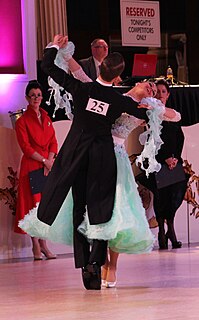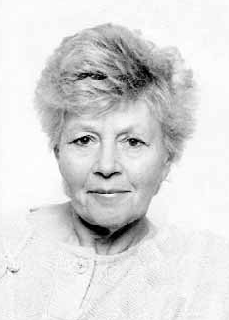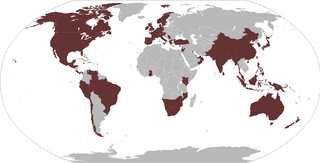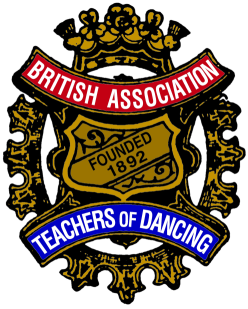
Ballroom dance is a set of partner dances, which are enjoyed both socially and competitively around the world, mostly because of its performance and entertainment aspects. Ballroom dancing is also widely enjoyed on stage, film, and television.
The Cecchetti method is variously defined as a style of ballet and as a ballet training method devised by the Italian ballet master Enrico Cecchetti (1850–1928). The training method seeks to develop essential skills in dancers as well as strength and elasticity. Cecchetti-trained dancers are commonly found in ballet and other dance companies throughout the world.
This is a list of dance terms that are not names of dances or types of dances. See List of dances and List of dance style categories for those.

Doreen Bird MA FISTD ARAD was a British dance teacher and founder of the Doreen Bird College of Performing Arts in Sidcup, Kent. She was a fellow, examiner, lecturer, committee and council member of the ISTD, life member of the RAD, and Honorary MA. Prior to her death from Leukaemia in 2004, she had been studying towards a Ph.D. As well as being a respected dance figure in the United Kingdom, Bird also travelled the World as a lecturer and adjudicator specialising in dance and musical theatre. The college which Bird founded is now recognised Internationally as a centre of excellence for dance and performing arts, with its students working worldwide in high-profile areas of the performing industry including West End and Broadway theatre.
Rhumba, also known as ballroom rumba, is a genre of ballroom music and dance that appeared in the East Coast of the United States during the 1930s. It combined American big band music with Afro-Cuban rhythms, primarily the son cubano, but also conga and rumba. Although taking its name from the latter, ballroom rumba differs completely from Cuban rumba in both its music and its dance. Hence, authors prefer the Americanized spelling of the word (rhumba) to distinguish between them.

The quickstep is a light-hearted dance of the standard ballroom dances. The movement of the dance is fast and powerfully flowing and sprinkled with syncopations. The upbeat melodies that quickstep is danced to make it suitable for both formal and informal events. Quickstep was developed in the 1920s in New York City and was first danced by Black Americans. Its origins are in combination of slow foxtrot combined with the Charleston, a dance which was one of the precursors to what today is called swing dancing.
Formation dance is a style of ballroom dancing. It is pattern or shadow team dancing by couples in a formation team. The choreography may be based on a particular dance or a medley of dances. Formation dancing may be done for exhibition or for competition between teams. There is also a type of formation in Bhangra.

The Imperial Society of Teachers of Dancing (ISTD) is an international dance teaching and examination board based in London, England. The registered educational charity, which was established on 25 July 1904 as the Imperial Society of Dance Teachers, provides training and examinations in a range of dance styles and certified dance teacher courses. The ISTD is recognised by the Qualifications and Curriculum Authority and the Council for Dance Education and Training and is also a member of the British Dance Council. It hosts various competitions in many different formats including Modern Ballroom, Latin American, Classical Ballet and Tap Dance as well as contemporary styles like Disco Freestyle.

The International Dance Teachers Association (IDTA) is a dance teaching and examination board based in Brighton, England. Operating internationally, the IDTA currently has over 7,000 members in 55 countries. The IDTA is recognised by the national qualifications regulators in England and Wales, Ofqual and the Council for Dance Education and Training, and is also affiliated to the British Dance Council, the Central Council of Physical Recreation and the Theatre Dance Council International. The IDTA works in partnership with the Royal Academy of Dance. The IDTA publishes a print and online magazine for members titled Dance International four times a year.

The Royal Academy of Dance (RAD) is a UK-based examination board specialising in dance education and training, with an emphasis on classical ballet. The RAD was founded in London, England in 1920 as the Association of Teachers of Operatic Dancing, and was granted a Royal Charter in 1935. Queen Elizabeth II is patron of the RAD, and Darcey Bussell was elected to serve as president in 2012, succeeding Antoinette Sibley who served as President for 21 years.
The feather or feather step is a dance figure in the International Style foxtrot. Depending on a syllabus, it consists of three or four steps, with the third step done outside the lady with a slight turn in the body position to the right.

Waltz is one of the five dances in the Standard category of the International Style ballroom dances. It was previously referred to as slow waltz or English waltz.

The British Association of Teachers of Dance (BATD) is a UK-based dance examination board, with its Head Office in Glasgow, Scotland. The officially recognised date for the formation of the society is 30 November 1892, making it the first professional dance organization of its kind in the United Kingdom, and the second oldest in the world.
The British Dance Council was formed in 1929 as the Official Board of Ballroom Dancing (OBBD). The name was changed in 1985 to the British Council of Ballroom Dancing and in 1996, the name was changed to British Dance Council. The BDC is the recognised governing body for Ballroom, Latin American, Sequence & Freestyle Disco dance in the United Kingdom.
Monsieur Pierre was the professional name of Pierre Jean Philippe Zurcher-Margolle. He was a professional dancer and dance teacher, largely responsible for introducing the Latin American dances to England, and for codifying them, and laying the groundwork for their use in competitions and in social dance. The system he and his colleagues developed became the basis for all Latin and American competitions held under the World Dance Council (WDC).
Dimitri Petrides was a ballroom dancer who was instrumental in pioneering and developing Latin American dancing in England and later globally. He left Cyprus when he was eighteen with his mother after the death of his father, eventually settling in England. He was one of the founding members of the Latin-American Faculty of the Imperial Society of Teachers of Dancing, and wrote the first English textbook on the subject. He was a Fellow and Examiner of the ISTD.
Phil Winston is an English dancer, dance teacher and choreographer.
Jillian La Valette is a professional ballroom dancer and teacher. With her dance partner James Arnell she won the professional International Latin American Dance Championship six times between 1955 and 1965.

UKA Dance, formally known as the United Kingdom Alliance (UKA), is a dance teaching and examination board based in Blackpool, England, and operates internationally. UKA Dance was established in 1902 and provides training in a range of dance styles, with examination syllabi for students, and training courses for people wishing to become certified dance teachers.
There are several types of lock step in waltz dancing, including International Standard waltz. A "lock step" is when the moving foot approaches to the standing foot and crosses in front of or behind it, creating a "check" position.








